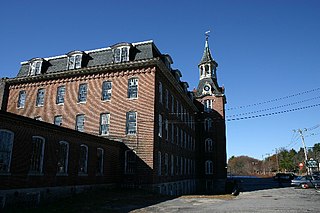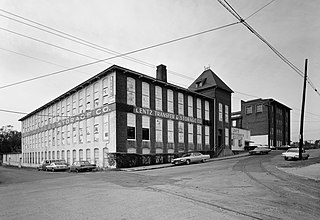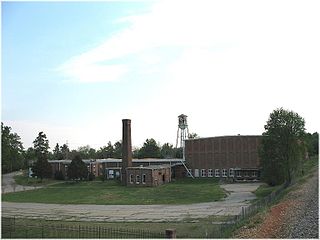
The Linwood Historic District is an industrial historic district in the Linwood village of Northbridge, Massachusetts. It is the site of the Linwood Cotton Mill and is roughly bounded by Linwood Avenue, Maple Court, and Pine Court. On June 16, 1989, it was added to the National Register of Historic Places.

Woodside Cotton Mill Village Historic District is a national historic district located in Greenville County, South Carolina. The district encompasses 278 contributing buildings and 2 contributing sites in an early 20th century urban South Carolina textile mill village. Centered on a mill founded by John T. Woodside in 1902, the district is located just west of the city limits of Greenville and is largely intact despite modernizations made by a succession of mill and home owners. The mill itself is a rectangular, brick, four-story building designed by J.E. Sirrine and built between 1902 and 1912. Eventually the mill became the largest cotton mill under one roof in the United States and one of the largest in the world.

Kendall Mill Historic District is a historic mill complex, mill village, and national historic district located at Camden, Kershaw County, South Carolina. The district encompasses 119 contributing buildings, 1 contributing sites, and 1 contributing structure in Camden. The district is centered on the Wateree Plant and associated structures that date from 1899 to 1923. The mill village to the south and southeast of the plant was built between 1900 and ca. 1925 and is a virtually intact reminder of the importance of the textile industry to South Carolina. The mill faces Kendall Park, a ten-acre landscaped park. On the eastern border of the park are the mill supervisors’ houses, built between 1900 and ca. 1925. The operatives house consist of one-story, 1 1/2-story, and a few two-story frame houses which date from 1900 to 1923. The district also includes Kendall Lake, north of the mill. The Dekalb Cotton Mill was organized in 1899. The Dekalb Mill building, designed by W.B. Smith Whaley in the Romanesque Revival style, was considered a model of textile architecture. The original plant building is a four-story rectangular brick building with a back stair tower and an imposing six-story front stair tower. The west addition to the plant, which is in keeping, architecturally, with the older buildings, was constructed in 1964. It is located in the City of Camden Historic District.

Buffalo Mill Historic District is a national historic district located at Buffalo, Union County, South Carolina. The district encompasses 190 contributing buildings and 2 contributing structures associated with the Buffalo Mill textile mill complex and mill village. The mill complex includes the main mill, mill office, power house, ice factory, mill warehouse, company store, and company bank/drug store. The main mill building features applied stylized Romanesque Revival detailing. The mill village housing varies from large, free-classic, Queen Anne style supervisor's houses, to shingle-style bungalows, to simple, one-story, workers residences. The village also includes a school and a baseball field/park.

Rock Hill Cotton Factory, also known as Plej's Textile Mill Outlets, Ostrow Textile Mill, and Fewell Cotton Warehouse, is a historic textile mill complex located at Rock Hill, South Carolina. The mill was built in 1881, and is a two-story, 12 bay by 16 bay, brick factory. It features a three-story tower at the main entrance. A number of additions have been made to the building. The Fewell Cotton Warehouse is a one-story, brick and wood frame warehouse built before 1894.

The Cocheco Mills comprise a historic mill complex in the heart of Dover, New Hampshire. The mills occupy a bend in the Cochecho River that has been site of cotton textile manufacturing since at least 1823, when the Dover Manufacturing Company supplanted earlier sawmills and gristmills. The present mill buildings were built between the 1880s and the early 20th century, and were listed on the National Register of Historic Places in 2014.

Glencoe Mill Village Historic District is a national historic district located at Glencoe, Alamance County, North Carolina. It encompasses 48 contributing buildings and 6 contributing structures built between 1880 and 1882 in Glencoe.
Bellemont Mill Village Historic District is a national historic district located at Bellemont, Alamance County, North Carolina. It encompasses 24 contributing buildings built between 1879 and 1880 in Bellemont. The district includes the three-story brick Bellemont Cotton Hill and 23 associated one and two-story frame mill houses.

Durham Hosiery Mill is a historic textile mill complex located at Durham, Durham County, North Carolina. It includes seven contributing brick buildings in the complex. The original Durham Hosiery Mill was built in 1902, and consists of a four-story main building with a six-story Romanesque Revival-style tower in front; engine, boiler, and heater houses attached at the rear, and a one-story dye house. The main building was expanded with a two-story annex in 1904, and a three-story annex in 1906. Other buildings include the triangular Annex No. 1 (1912) and a three-story brick finishing building. By 1910, the Durham Hosiery Mills Corporation was the largest manufacturer of cotton hosiery in the world. The mill was abandoned in 1922.

Erwin Cotton Mills Company Mill No. 1 Headquarters Building, also known as Erwin Square, is a historic textile mill complex located at Durham, Durham County, North Carolina. The mill was built in 1892, and is a two-story, 748 feet long, brick building. It features three square towers projecting from the east facade and hundreds of large and closely spaced windows. The building exemplifies "slow burn" construction with its exterior load bearing brick walls and its heavy timber heart pine beams and columns. The headquarters building is a Late Victorian style brick building built in 1892 and enlarged in 1896 and 1905. Attached to the headquarters building is a warehouse. In 1983–1984, the complex was renovated as offices and apartments.

Arista Cotton Mill Complex, also known as Salem Cotton Manufacturing Company and Arista Cotton Mill and Lentz Transfer & Storage Co., is a historic cotton mill complex located at Winston-Salem, Forsyth County, North Carolina. The complex includes two buildings: a brick building built in 1836 by part of the Moravian congregation of Salem and the original home of the Salem Cotton Manufacturing Company, and the other is the original Arista Mill, built in 1880 by F. and H. Fries Cotton Arista Mills. The 1836 Salem Cotton Mill is a three-story, brick building with a monitor roof. The 1880 mill is a three-story brick building, 14 bays long, with bracketed eaves with timber supports. A two-story roughly triangular brick building was added about 1900. The 1836 building has been converted to a hotel known as The Historic Brookstown Inn.

Sterling Cotton Mill, also known as the Franklinton Cotton Mill, is a historic cotton mill complex located at 108-112 East Green Street in Franklinton, Franklin County, North Carolina. The main mill is a one and two-story L-shaped brick building with Industrial Italianate style design elements. The mill consists of five sections: the original gabled one-story section rising to a two-story section at the east end (1895); a two-story addition (1914), a one-story addition (1960s); pre-1926 "cotton sheds"; and a small two-story brick office (1966). Associated with the mill is the contributing detached chimney stack. The mill was built by Samuel C. Vann, whose son Aldridge built the Aldridge H. Vann House. The mill closed in 1991.
Mount Holly Cotton Mill, also known as Alsace Manufacturing Co., is a historic cotton mill complex located at Mount Holly, Gaston County, North Carolina. The original section was built in 1875, and is a 3 story, rectangular brick mill building with Industrial Italianate detailing. A three-story addition was built in 1916, and a one-story, T-plan brick machine shop and boiler house was added in 1919. The complex was converted into a research unit in 1953, and in 1973 was sold to an independent mill operator who presently uses the building for a variety of industrial and commercial purposes.

Eureka Manufacturing Company Cotton Mill, also known as Tait Yarn Company and Lincoln Bonded Warehouse Company, is a historic cotton mill located at Lincolnton, Lincoln County, North Carolina. It was built between 1907 and 1910, and is a two-story, brick factory building with a three-story stair tower. Adjacent to the factory is a two-story brick office building built between 1902 and 1906. The buildings housed the Eureka Manufacturing Company from 1906 to 1937, and Tait Yarn Company from 1949 to 1966. Lincoln Bonded Warehouse occupied the buildings into the late-1990s. The buildings are owned by the Lincoln County Historical Association.

Former Parks-Cramer Company Complex is a historic factory complex located at Charlotte, Mecklenburg County, North Carolina. The contributing resources are the Manufacturing Building; Shipping, Receiving, and Pipe Storage building; storage building; and rail spur line and they were developed between 1919 and 1955. The Manufacturing Building is divided into six sections, and is a large one-story brick building with a flat roof and stepped parapets It features banks of large, steel-sash factory windows. The Parks-Cramer facility was one of the region's foremost manufacturers of humidifiers and air-conditioning equipment for the new cotton mills.

Piedmont Buggy Factory, also known as Bearskin Cotton Mills and Monroe Cotton Mills, is a historic building located at Monroe, Union County, North Carolina. It was built in 1910, and is a three-story, rectangular brick building with a shallow pitched gable roof. The brick is in six distinct shades of red. Also on the property are the contributing late-1910s one-story brick boiler house and a steel water tower. Originally built as a buggy factory, in the late 1910s the factory was converted to textile production and renamed the Bearskin Cotton Mills. The facility remained in operation through 1956.
Royall Cotton Mill Commissary is a historic commercial building associated with the Royall Mill and located at Wake Forest, Wake County, North Carolina. It built in 1900, and is a two-story, rectangular brick building with a low gabled metal roof and stepped parapet. It measures 32 feet by 100 feet and has segmental arched windows. The Royall Cotton Mill Commissary closed in 1934. The building has been rehabilitate into apartments.

Borden Manufacturing Company, also known as Goldsboro Cotton Mills and Wayne Cotton Mills, is a historic factory complex located at Goldsboro, Wayne County, North Carolina. The complex includes the Goldsboro Cotton Mills (1892), Goldsboro Smokestack (1905), Goldsboro Boiler Room, Borden-Goldsboro Pedestrian Bridge, Borden Manufacturing Company (1900), Borden Water Tank, Borden Auto Garage, Borden Reservoir, Borden Reservoir Pump House, Borden Railroad Siding Tracks, Borden Conditioning Room, and Borden Storage Building. The Goldsboro Cotton Mills is a two-story, 16 bays long, gable-front, brick building with Italianate style detailing. It features a central three-story square tower, three bays in width.

The Pickett Cotton Mills is a historic industrial property at 1200 Redding Drive in southwestern High Point, North Carolina. The mill complex includes the original 1911 two-story brick-and-concrete mill building, a storage warehouse, office building, and sprinkler house. The Pickett Cotton Mill Company was founded in 1910, and was the first successful textile operation in the city. The mill was closed in 1985 due to stiff foreign competition. The main mill is an exemplary instance of sturdy, high-quality construction of the period, and the office building, which is also typical of the period, is one of the few to survive.

Minneola Manufacturing Company Cloth Warehouse is a historic mill complex in Gibsonville, Guilford County, North Carolina.





















